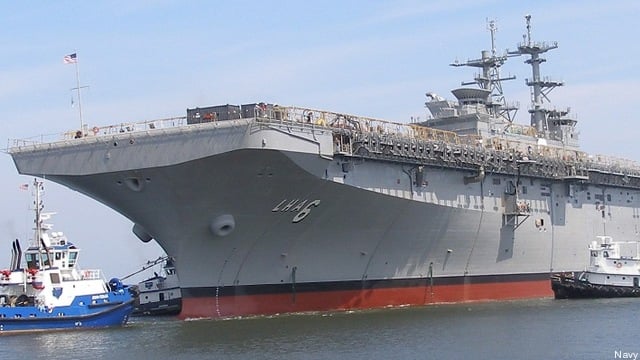 The Navy will christen its newest amphibious warfare ship in Pascagoula, Miss. on Oct. 20th. The boldly-named, $3 billion America is a major departure from past designs — and, quietly, the Navy has decided not to build many more like it in the future.
The Navy will christen its newest amphibious warfare ship in Pascagoula, Miss. on Oct. 20th. The boldly-named, $3 billion America is a major departure from past designs — and, quietly, the Navy has decided not to build many more like it in the future.
The Chief of Naval Operations himself, Adm. Jonathan Greenert, has said that getting more amphibs in the fleet is his “biggest shipbuilding concern.” But the Navy is only building two vessels to the LHA-6 blueprint, America itself and LHA-7 Tripoli, for which shipbuilder Huntington-Ingalls recently received a fixed-price contract. Subsequent LHAs will revert to a more traditional design.
At issue is LHA-6’s and -7’s lack of what’s called a “well deck.” Most amphibs have a large compartment they can flood partway with water, with a door in the stern of the ship that can be lowered to let smaller vessels in and out. That makes for easy loading and unloading of the amphibious armored vehicles, hovercraft, and other landing craft that carry Marines and their heavy gear ashore. Otherwise such small craft have to tie up alongside the big ships while equipment is lowered by cranes and troops climb down rope ladders, a slow, laborious, and dangerous process, as the military learned in World War II. Since then, well decks have become a defining feature of the amphibious fleet — but they take up a lot of room.
Meanwhile, aircraft have become ever more important to Marine Corps operations. Older ships were designed to carry conventional helicopters like the CH-46 and the Marine Corps’s Harrier “jump jet,” but their successors — the V-22 Osprey tilt-rotor and the F-35B version of the Joint Strike Fighter — are much larger machines that take up much more space. So when the Navy looked at replacing its aging LHA-1 Tarawa class ships, it decided to sacrifice the well deck to better accommodate aircraft.
The result is what any other navy would simply call an aircraft carrier. At 844 feet long and 45,000 tons displacement, LHA-6 America is only slightly smaller than the Russian-made Varyag now in Chinese service and significantly larger than the French carrier Charles de Gaulle (neither of which has a well deck, either). Only the US Navy, with its 1,000-foot-long, 100,000-ton Nimitz class, would consider the America a small carrier.
Ships of LHA-6’s size have proven useful in all sorts of operations, notably last year’s intervention in Libya, when the amphibious ship USS Kearsage led US air operations in the absence of a Nimitz-class ship. Kearsage, designated LHD-3, is a traditional amphib design with a large well deck, which was idle in the air-only operations against Gaddhafi. In the same scenario, LHA-6 could provide more airpower in an equivalently sized package.
The problem is, of course, that not all or even most future operations will be like Libya in 2011. The whole point of having a Marine Corps is so they can go ashore. Modern Marine tactics de-emphasize storming the beach in landing craft a la Tarawa in World War II and instead focus on bypassing enemy defenses by flying forces deep inland. (That mission drove the V-22’s unique design). But landing craft are still essential, less for the first wave ashore than to sustain the operation with bulk supplies and heavy equipment — trucks, artillery, tanks — that aircraft can carry only in small amounts or not at all. And if landing craft are essential, then so is the well deck.
So this February, after months of study, the Marine Corps Commandant and the Chief of Naval Operations signed an official memorandum of agreement that restores the well deck to LHA-8 and subsequent ships. A modification of the LHA-6 America design, LHA-8 will have a slightly smaller hanger than the America and a slightly smaller well deck than past amphibs like the Kearsage. (A redesign of the “island” structure will free up more room on LHA-8’s flight deck to do maintenance on V-22s, compensating for some of the hanger space lost inside the ship).
Four years ago this September, before the keel was even laid for LHA-6, a former Marine named Bob Work — now undersecretary of the Navy — said there were big questions about the design. “Will it become the standard, or will it become only a niche capability?” Work said to National Defense magazine. The answer is now clearly, “niche.” LHA-6 might count as a carrier in any other navy, but in the US fleet, it is a highly specialized and not entirely happy compromise between the massive airpower of the Nimitz class and the flexibility of the traditional Marine amphibious ship.
SECNAV floats idea of co-production with foreign shipyards
Del Toro has repeatedly praised shipbuilders in South Korea and Japan for their abilities to keep construction efforts on time.


























